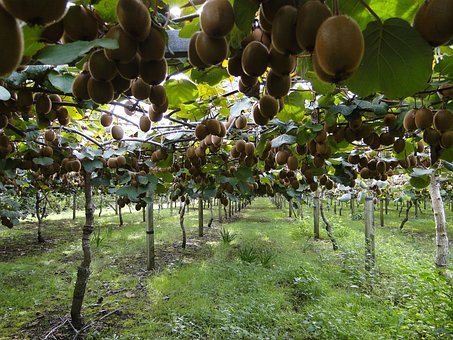Kiwi Farming : As a result, the Kiwi fruit is often called Chinese Gooseberry, since it originated in China. There has been an increase in demand for the fruit in India because of its health benefits
-
A simple cultivation process
-
Benefits to health and nutrition
-
Profits can be increased by lowering costs
Let’s first explore kiwi fruit advantages before learning how it is grown, cultivated and harvested in India.
Benefits of Kiwi Fruit: Are They Nutritious and Healthy?
The kiwi fruit contains Vitamin C and beneficial dietary fibre that promotes a variety of health benefits. The health benefits of this oval-shaped fruit include immunity, heart health, and digestive health.
Fruits like these, approximately the size of an egg, are healthy because they contain antioxidants. Served as a snack or as an ingredient in some unique desserts, its appealing texture, tart taste and low calories make it an ideal choice. Vitamins, health benefits, and rich taste make Kiwi fruit a perfect option for snacking. Let’s take a closer look at its health benefits.

Kiwi Fruits Benefits Immunity boosting benefits of Kiwi
The vitamin C content of kiwis exceeds 230% of the daily recommended dose. Vitamin C assists in strengthening your immune system.
Furthermore, it contains antioxidants that help fight free radicals and reduce stress, inflammation, and disease.
Restore the health of your heart with Kiwi
The kiwi fruit is good for lowering blood pressure. In this way, strokes and heart diseases are reduced.
The fibre in it helps lower LDL and bad cholesterol, which can cause hardening of arteries. Also, fiber prevents constipation and other gastrointestinal issues.
A Kiwi Can Help Fight Asthma
Kiwi fruit has been shown to alleviate asthmatic wheezing. Children with asthma have found the fruit particularly beneficial. Consuming it has provided them with a great deal of relief.
Healthy Eyes with Kiwi
Green-coloured fruit rich in antioxidants and carotenoids provides good immunity for eyes and the ovaries.
People are in absolute demand for kiwi fruit because it is nutritious and healthful. India cultivates and distributes the following varieties of Kiwi fruit.
The most popular varieties of Kiwi grown in India
In India, there are several types of kiwi fruit that are popular.
- Abbott
- Allison
- Bruno
- Hayward
- Monty
- Tomuri
The next step is to understand how kiwis are grown in India. Detailed information on planting, growing, and harvesting Kiwi fruit types will be discussed next. We will go over the factors that affect kiwi farming in India in a nutshell.
The technical requirements for growing Kiwis in India
The climate and soil conditions in India are suitable for commercial Kiwi farming. In order to ensure a high quality harvest and yield, the following technical requirements must be met. Let’s step by step explore these requirements.
1.Climate & Soil Requirements : Humidity and warmth are ideal growing conditions for kiwi fruit. Additionally, the fruit requires fertile and well-drained loamy soil in a yellow-brown shade. In addition, wind shelterbelts are important for protecting immature fruits.
During the cropping phase, it is also important to check Nitrogen (200kg/ha), Potassium (150kg/ha), and Phosphorus (55 kg/ha) content in soil.
2. Preparation of the land for kiwi cultivation : Kiwi plantations can benefit from contours or terraces if the land is steep or sloppy. To maximize sunlight, roots must be aligned north-south. It is a good idea to start pitting and manuring as early as possible in December, and to plant as soon as possible in January.
It is necessary to level and plough Kiwi fruit trees before they are planted. A sure bet is to add tractors from Mahindra and Sonalika. Furthermore, it is highly recommended to add the latest farming implements such as rotavators, cultivators, and ploughs to till and stir the soil.
3.The Kiwi Cultivation Plantation Process : You can grow Kiwi plants in January by using seed/seedlings or by grafting. A pergola or arbor framework with a 6 m row spacing is ideally suited for plantation procedures. For pollination to begin, the male to female plant ratio should be 1:5.
4.Kiwi Cultivation Fertilizer & Nutrition Schedule : It is highly recommended to use 20kg farmyard manure with 0.5 kg NPK mixture with 15% nitrogen when growing Kiwi fruits. Farmers must apply the same amount of manure and NPK schedule five years after planting:
- Nitrogen – 850-900 g
- Phosphorus – 500-600 g
- Potassium – 800-900 g
5.The irrigation of kiwi fruit : It is best to irrigate the fruit between September and October when it is in its initial growing stage. Plants can be irrigated at intervals of 10-15 days to grow in a healthy, fruit-bearing environment.
6. The pruning of kiwis : The kiwi vine can grow in great abundance and become overloaded as it grows. Therefore, pruning is highly recommended. The vine should be pruned soon after planting. In order to prune, follow these steps:

Pruning of Kiwi -
The vine should be tied loosely to a pole and allowed to grow straight.
-
In any case, vines shouldn’t be woven around poles.
-
The vine should also be clipped until it reaches the top of the pole.
-
Removing the top half of the vine will allow the vine to grow laterally along the wires.
Vine pruning should be done in winter. It is recommended to trim vines’ side branches by approximately half. This is two feet long. The following year, try again to grow the side trenches.
7.It is intercropping : A good distance between legumes and vegetables should be maintained alongside kiwi plants when intercropping. Moreover, Kiwi plants aren’t susceptible to pests or diseases. Crops can be grown effortlessly with proper care and maintenance.
8.Fruit harvesting for kiwi : Kiwi plants begin bearing fruit within 4-5 years of planting. Within 6-7 years, however, they begin to produce commercially.
Fruits that grow large are usually harvested first, while fruit that grows smaller is given complete space to grow and mature. After 1-2 weeks, hard fruits become soft and edible after being carried in coarse cloth to the market.
The conclusion
As a result of India’s favourable climatic and soil conditions, kiwi fruit farming is highly profitable. Kiwi trees can produce 30-40 kg of fruit per year. The price of a single Kiwi fruit in India is Rs 30-40. Farmers in India, therefore, can earn huge profits if they cultivate this nutritive, green fruit.
Now that farmers know how to grow kiwi plants in India, they can cultivate them with ease. A quality and profitable yield can be produced by addressing the discussed technical factors. You can start Kiwi farming in India and make sustainable profits with the above guide.



[…] Read More: Farming Kiwi Fruit in India: Steps, Benefits & Profits […]
[…] Read More: Farming Kiwi Fruit in India: Steps, Benefits & Profits […]